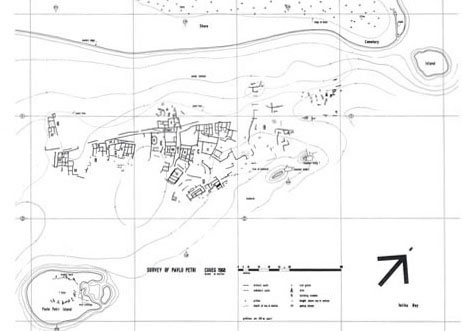Project Background
In 1967 Nic Flemming of the Institute of Oceanography, University of Southampton, discovered submerged ruins just off the coast of south-eastern Laconia in the west end of the Bay of Vatika just opposite the island of Elaphonisos (Flemming 1968a, 1968b, 51ff.).
In 1968 a team from the University of Cambridge surveyed the remains over six weeks using a fixed grid system and hand tapes (Harding et al. 1969). They produced a plan of a prehistoric town, thought to be Mycenaean, covering an area of about 300m by 150m, lying in one to four metres of water. At least fifteen separate buildings (consisting of a series of rooms), courtyards,

Click image to see a full-size version
streets, two chamber tombs and at least thirty-seven cist graves were identified. The underwater site was seen to continue southward on Pavlopetri island on top of which the remains of walls and archaeological material were still visible. The 1968 project recovered a small amount of surface finds from the seabed (mainly pottery but also obsidian and chert blades and a bronze figurine) which suggested a date range from the Early to the Late Bronze Age (c. 2800-1180 BC). On comparison with other known archaeological sites, however, the submerged buildings at Pavlopetri were thought to date mainly from the Mycenaean period (1650-1180 BC) though this could not be confirmed from survey evidence alone.
Snorkellers record the site in 1968
As a likely Mycenaean town, the site offers potential new insights into the workings of Mycenaean society, interpretations of which are currently dominated by the evidence from the better known palaces and citadels of the period. Pavlopetri has an added importance in that it was a maritime settlement where there was likely to have been a harbour from which the inhabitants coordinated local and long distance trade - its sandy and well-protected bay would have been ideal for beaching Bronze Age ships. Despite the potential international importance of Pavlopetri, however, no further work was carried out at the site after it was first mapped in 1968.